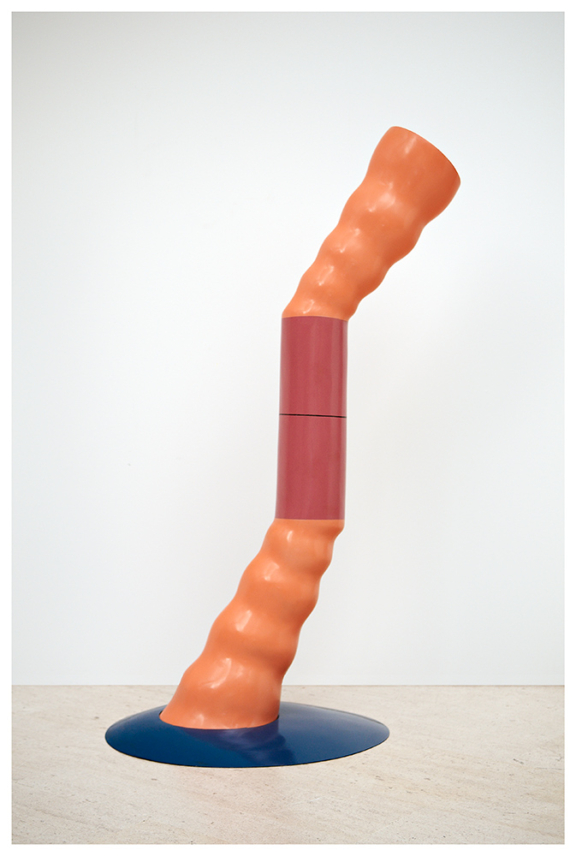
- 1963
- Plastic
- A definir
- Inv. EE26
Phillip King
Ripple
Ripple is a typical example of the lucid, materialistic quality with which New Generation artists attempted to invest the work of art. Made of plastic, a material which Phillip King was the first to use and process, it strikes one as a compact, uniform entity that defines the space it occupies. Compositional austerity, the absence of formal references, the absence of narrative content, a provocatively materialistic character and an ostensible link between the work’s design and the rational nature of industrial production are some of the elements that contribute to placing the work in the apparent realm of objects.
And yet, despite King’s interest in minimizing the extent to which any autobiographical or subjective intervention might occur – an interest he shared with other artists from St. Martin’s – he was the only one to leave the work open to the possibility of being interpreted with a touch of subjectivity and emotion: a possibility that is also hinted at in the work’s title. Ripple epitomizes the age’s dominant trend regarding the morphology of sculpture: seemingly weightless, almost intangible forms that tended to spiral upward triumphantly – a sign perhaps of the general sense of optimism and euphoria that prevailed throughout British society at the time. Harmony of form in Ripple counteracts motion; colour unifies the undulating whole and reflects the light wherever it may fall on the work’s surface. The intrinsic rhythm of the overall visual result creates the impression of a three-dimensional work of painting, while shape and form occupy natural space keeping to a human scale – the viewer’s scale. King applied Anthony Caro’s basic principles regarding sculpture, and yet from very early on he went on to discover different types of visual potential inherent in the clear surface, while manipulating and modifying colour and its illusory potential in more subtle ways.
King – an artist originally influenced by the light of his homeland, Tunisia, and by the texture of its soil, by classical forms found in the architecture and sculpture of ancient Greece, as well as by the gestural, unadorned language of painting in the tradition of American Abstract Expressionism – would create a number of sculptures in the course of the 60s, which have a silent yet dynamic presence inspace and which take on the quality of a conceptual pun, reflecting – through the shape of the cone, the circle, the square – the quality of the ephemeral and the age’s popular and mass character. After 1964, King’s sculptural compositions acquired a relatively more intricate, multi-dimensional form. He began using steel, as well as wood – which he had used more extensively at the beginning of his career – and his works began to expand through space and to engage in a direct relationship with their surroundings, thus acquiring a public, almost monumental quality.
Margarita Kataga
May 2010
| Type | Value | Unit | Section |
| Height | 188 | cm | |
| Depth | 77 | cm | |
| Width | 89 | cm |
| Type | Acquisition |
| A Ilha do Tesouro / Treasure Island |
| CAMJAP/FCG |
| Curator: CAMJAP/FCG |
| 7 de Fevereiro de 1997 a 4 de Maio de 1997 Todo o espaço expositivo do CAM - pisos 0, 1 e 01, e Galeria de Exposições Temporárias. |
| Comissários da exposição: Jorge Molder e Rui Sanches. |
| Metamorphosis - British Art of the Sixties: works from the collections of the British Council and the Calouste Gulbenkian Foundation |
| Basil & Elise Goulandris Foundation - Museum of Contemporary Art |
| Curator: Fleurette P. Karadontis |
| 26 de Junho de 2005 a 25 de Setembro de 2005 Basil & Elise Goulandris Foundation - Museum of Contemporary Art |
| Comissários da exposição: Richard Riley, British Council, London, e Ana Vasconcelos e Melo, CAMJAP-FCG, Lisboa. |
| 100 Obras de Arte Britânica Contemporânea |
| Fundação Calouste Gulbenkian |
| Curator: Fundação Calouste Gulbenkian |
Galeria de exposições temporárias, FCG |
| Exposição realizada em Janeiro 1971, na Galeria de exposições temporárias, FCG. |
| Blast to Freeze: British Art in the Age of Extremes |
| Musée d'Art Contemporain Les Abattoirs |
| Curator: Musée d'Art Contemporain Les Abattoirs |
| 24 de Fevereiro de 2003 a 2 de Maio de 2003 Musée d'Art Contemporain Les Abattoirs, Toulouse |
| Estima-se que 35 000 visitantes tenham visitado a exposição. |
